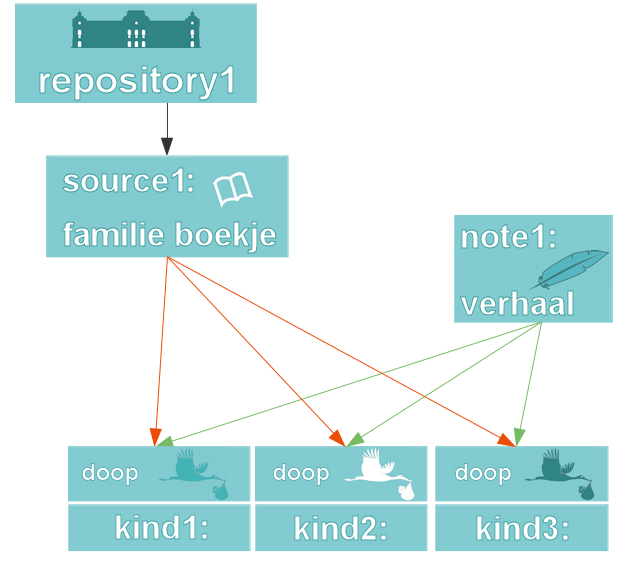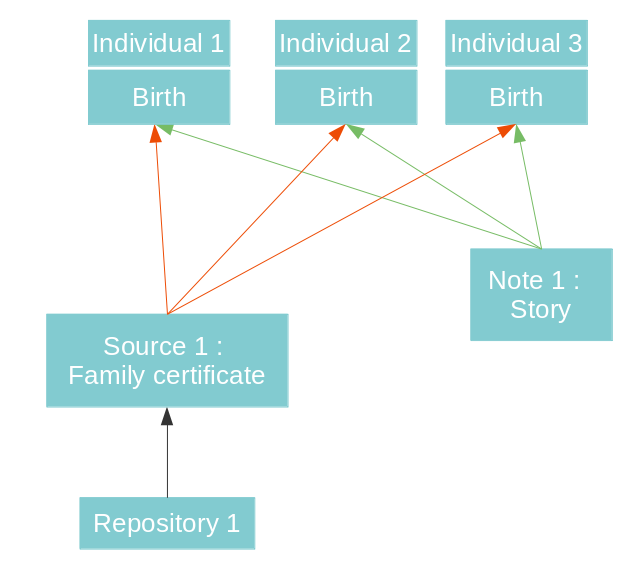Gedeelde informatie in Gedcom en Ancestris
Sommige stukjes informatie die in een stamboom zijn verzameld, kunnen ofwel specifiek zijn voor een individu, ofwel deze informatie kan worden gedeeld door meerdere individuen of meerdere families van die stamboom. Bijvoorbeeld een familiefoto hoort bij diverse familieleden, een portretfoto maar bij eentje.
Een stamboom bevat heel veel informatie en het meeste daarvan zult u willen hergebruiken.
Als u informatie wilt hergebruiken raden we ten zeerste aan om deze in eerste instantie op te slaan als losse entiteit, en niet als een eigenschap (property), dus niet als onderdeel van een andere entiteit. Op die manier is de informatie herbruikbaar!
Dit is het geval voor alle Notes, alle Sources (bronnen), alle Repositories (Archieven) en alle Multimedia Elements.
Een uitgebreide uitleg van de verschillende entiteiten, welke er zijn en wat voor gegevens ze bevatten, vind u op de speciale entiteiten-pagina.
Andere informatie in Ancestris kunt u vaak op een transparante manier hergebruiken. Dit zijn bijvoorbeeld beroeps omschrijvingen, gebeurtenis omschrijvingen, omschrijvingen van een diploma enzovoorts. Algemeen gesteld zijn het dus de korte labels die iets beschrijven.
Het principe van informatie aanmaken
Het principe om informatie aan te maken in Ancestris, is het volgende: Vraag uzelf steeds af of de informatie die u wilt invoeren, waarschijnlijk opnieuw zal worden hergebruikt door andere personen dan degene waaraan u nu bezig bent, of aan andere entiteiten in het algemeen.
Aanmaken van gedeelde informatie
Als de informatie hoogstwaarschijnlijk hergebruikt gaat, of kan worden:
- Maak de entiteit eerst aan als "losse", op zichzelf staande entiteit
- Koppel deze losstaande entiteit vervolgens aan de andere entiteit die deze losstaande entiteit zal gaan gebruiken.
In bepaalde gevallen is het duidelijk dat een entiteit zal worden hergebruikt, zoals bijvoorbeeld bij een archief (Repository).
In andere gevallen is de keus niet altijd meteen duidelijk zoals bijvoorbeeld bij een notitie (Note).
Entiteiten die gedeelde informatie gebruiken
Een ander voordeel van het gebruik van gedeelde entiteiten is, wanneer u wilt weten, welke entiteiten nu precies welke informatie gebruiken. Hiervoor gebruikt u de entiteiten lijst. U selecteert hier de gedeelde entiteit en kunt dan in een hieraan gekoppelde sub-lijst zien, welke andere entiteiten deze zelfde informatie gebruiken. U selecteert bijvoorbeeld een notitie en kunt dan precies zien waar deze notitie wordt gebruikt.
Omgekeerd kunt u zo ook zien of een bepaalde gedeelde entiteit eigenlijk nog wel ergens gebruikt wordt.
Voorbeelden
Repository voorbeeld:
Tijdens uw genealogisch onderzoek vindt u waarschijnlijk meerdere documenten die afkomstig zijn uit hetzelfde Archief (Repository).
U maakt dit archief natuurlijk slechts éénmaal aan, zodat u al uw gevonden bronnen (Sources) uit dit archief, ook hiernaartoe kunt verwijzen. En van dit archief noteert u dan alle gegevens (Properties) zoals naam, adres, telefoon, website enzovoorts.
Elk van deze bronnen die uit dit archief afkomstig is, laat u dan naar dit zelfde archief verwijzen.
Dit archief kan ook een regionaal archief zijn, een gemeentehuis, een website of een begraafplaats bijvoorbeeld.
Hier een voorbeeld van 3 sources uit hetzelfde archief:
Voorbeeld van een familie boekje
Stel u ontdekt een familie boekje waarin 3 kinderen staan vermeld, en u schrijft ook een notitie waarin u uw onderzoek uitlegt, dan heeft u een schema wat er zo uitzien:
De 3 kinderen (personen) vertegenwoordigen de broers en zussen. Hun geboortes (dopen) zijn afkomstig uit het familieboek zelf, dat is de bron (Source). En dat familieboek is weer afkomstig uit een archief (Repository).
Het verhaal (de Note of notitie) is van uzelf, ter ondersteuning van het onderzoek of van de observaties over deze 3 geboortes (dopen).
U ziet in dit schema dat de bron (Source), in dit geval het familieboekje, gekoppeld is aan de doop van elk kind, dus niet aan het kind (persoon) zelf. Dit is nauwkeuriger. De doop is immers een Property (eigenschap) van elk kind.
In dit voorbeeld gaan we er van uit dat de notitie (het verhaal of de Note), alleen gaat over de geboortes (dopen) zelf. En niet over het leven van elk kind in bredere zin. Want als het over meer gaat dan alleen de doop, dan is het beter om de Note (de notitie of het verhaal) te koppelen aan elk kind en niet aan de Property "geboorte of doop".
====================================================================================
Case of a family certificate
If you discover a family certificate in which are indicated 3 children, and that in addition you write a note explaining your research story, you will have a diagram which could look like this:
The 3 individuals represent the siblings. Their births are sourced from the family certificate, which itself is sourced from a repository.
And your note comes in to support your research or observations about the 3 births.
You will notice in the diagram above that the source relates to the birth events of individuals, and not the individuals directly, which is more precise.
I assumed in the example that your note only spoke about the births of individuals. If it talked about their lives more broadly, you should probably link your note to the individuals rather than just to their birth.
Case of a note
On the other hand, a note which comments on specific circumstances relating only to one single individual in particular should preferably be entered as an individual note and not generate the creation of a dedicated Note entity.
This is the case, for example, for details of a birth (the height and weight of the child, the fact that the person was born at his parents' home, etc.). These details will only ever relate to the birth of the individual considered and it is more efficient to enter this information directly at the birth level as an individual note.
Case of a place
The first time a place is created, it appears in the event where it is used first. Ancestris does not allow you to put it in a Place entity, even if you think you might need to reuse it later. This is because the Gedcom standard did not define places as entities.
This is not a problem, Ancestris manages the repository of places for you and considers that each place can be reused.
However, you must be careful when you create a place: it is up to you to check if it does not already exist, in order to avoid creating a duplicate. A duplicate on a place is not annoying as such, but it becomes so when, for example, you correct one of the two while thinking of correcting them all.
To avoid generating a duplicate when entering a place, Ancestris automatically suggests all the places found in your genealogy that include the text being entered.
Also, thanks to the List of places view, it is possible to merge places that have been entered twice by mistake.
Steps
Creation
The creation of Notes, Sources, Repositories, and Multimedia Elements is done either via the Context Menu of Ancestris, or via the menu bar, or automatically from the Cygnus editor or manually from the Aries editor.
The creation of places is done by entering a place directly in the editors, or in the Places editor.
Link
The link to an existing Note, Source, Repository, or Multimedia Elements is done via the Context Menu of Ancestris or via the Editors.
The link to an existing place is done as when it was created: when entering a place directly in the editors, or in the Places editor.
Usage
To find out the list of entities using a particular Note, Source, Repository or Multimedia Element, all you have to do is select it from the table of entities for example, and view it in the Gedcom Editor.
You will then see all the entities using this information as linked properties.
Here is an example of source S5 that we have selected in the table of entities. If we look at the Gedcom Editor, we see the following:
This source S5 is used by four other entities of the genealogy: the note N2 on the assassination by Ravaillac, the name of the individual I29 Robert Capet, the death of Louis IX, and the name of Marguerite de Provence.
In the case of a Place, the easiest way to find out in which events it is used, is to go to the List of Places and select it. Events are listed by expanding the flap in the list. See the List of Places for more details.
B-A BA
There is an educational B-A-BA on shared information in PDF format. It is written in French.
It corresponds to version 9 of Ancestris but most of it is still relevant.
It tells you in detail how to create and use each of the shared entities presented above.
You can download it here.




